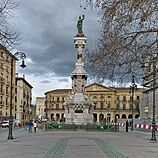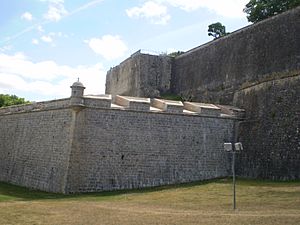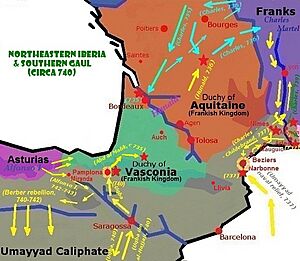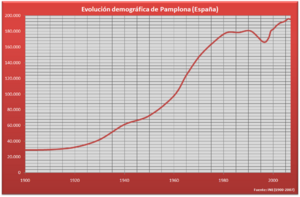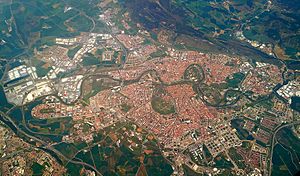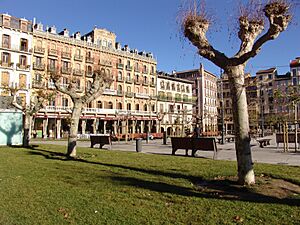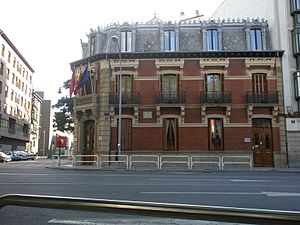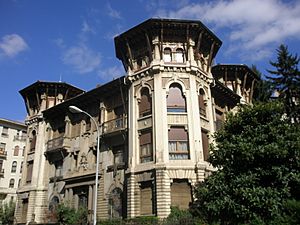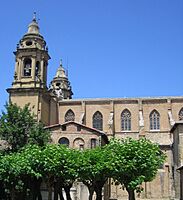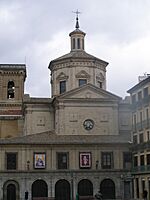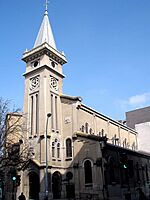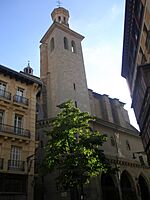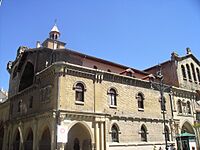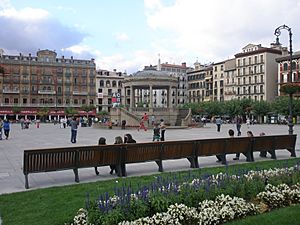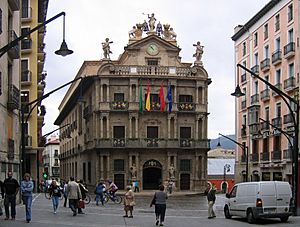Pamplona facts for kids
Quick facts for kids
Pamplona
Iruña (Basque)
Pampeluna
|
|||
|---|---|---|---|
| Pamplona / Iruña | |||
|
|
|||
|
|||
| Country | |||
| Autonomous Community | |||
| Comarca | Cuenca de Pamplona | ||
| Founded | 74 BC | ||
| Area | |||
| • Municipality | 25.14 km2 (9.71 sq mi) | ||
| Elevation | 450 m (1,480 ft) | ||
| Population
(2020)
|
|||
| • Municipality | 209,672 | ||
| • Density | 8,340.2/km2 (21,601/sq mi) | ||
| • Metro | 319,208 | ||
| population-ranking: 29th (municipality); 23rd (metro area) | |||
| GDP | |||
| • Metro | €18.942 billion (2020) | ||
| Time zone | UTC+1 (CET) | ||
| • Summer (DST) | UTC+2 (CEST) | ||
| Patron saint |
|
||
Pamplona (also called Iruña in Basque) is an important city in Spain. It is the capital of the Chartered Community of Navarre.
This city is about 450 meters (1,476 feet) above sea level. It sits in a flat area near the Arga river. People have lived here since the late Bronze Age or early Iron Age. But the city officially started around 75 BC. A Roman general named Pompey founded it.
Pamplona is famous around the world for its exciting running of the bulls. This event happens during the San Fermín festival. The festival takes place every year from July 6th to July 14th. A famous writer, Ernest Hemingway, made the festival even more well-known in his 1926 novel, The Sun Also Rises. Pamplona is also home to Osasuna, a football team that plays in Spain's top league, La Liga.
Contents
History of Pamplona
How Pamplona Began: Roman Times
Around 75-74 BC, a Roman general named Pompey set up a camp here during a war. He is thought to have founded the city, calling it Pompaelo. This name later became Pamplona. However, the area was already home to the Vascones people. They called their main town Iruña, which means 'the city'. Roman Pompaelo was an important town on a main road connecting cities like Bordeaux and Astorga.
Pamplona in the Early Middle Ages

Pamplona faced many challenges from invasions and attacks from the 400s to the 700s. It was sometimes ruled by the Visigoths or the Franks. But it often tried to rule itself. In 581, the Visigoth king Liuvigild took control of Pamplona. The first known bishop of Pamplona was in 589.
Around 711, Muslim armies from North Africa arrived in Spain. Pamplona made a deal with them and had a Muslim army stationed nearby. For a while, Pamplona was a base for expeditions into France. But later, the city became a battleground between different groups.
In 778, Charlemagne, a famous Frankish king, destroyed Pamplona's walls. He was worried the city might be used against him. After this, Pamplona was sometimes under Frankish rule and sometimes under Muslim rule. In 824, Enecco Arista became the first king of Pamplona. This new kingdom became more independent.
In 924, Pamplona was described as a poor fortress town. Its people mostly spoke Basque. Later, the city started to grow again. This was helped by the Way of St James, a famous pilgrimage route.
Three Boroughs Become One City
From the 11th century, Pamplona started to grow and become a city again. Two new areas, called burgos (boroughs), were built: San Cernín and San Nicolás. The original part of the city was called Navarrería. People from other parts of Europe, especially merchants, moved into the new boroughs.
These boroughs were very different and often fought with each other. In 1276, the Navarrería area was destroyed, and many people were killed. It was left empty for almost 50 years. To protect the city, a castle was built in the early 1300s where Plaza del Castillo is today.
Finally, in 1423, King Charles III united all three boroughs into one city. The walls between them were torn down. A new city hall was built where the dividing space used to be.
Pamplona also had a Jewish community for a long time. They had their own laws. But in 1498, Jewish people were either forced to leave or convert to Christianity.
Pamplona as a Fortress City
After Navarre was taken over by Spain in 1512, Pamplona remained its capital. But it became a Spanish military outpost. King Ferdinand V ordered a new castle to be built.
To make the city stronger, King Philip II built new fortifications starting in 1569. The city was surrounded by walls that made it almost a perfect five-sided shape. The citadel, a star-shaped fort, was built in the south. These walls were meant to protect the city and control the local people. The walls you see today were built between the late 1500s and 1700s.
In the 18th century, Pamplona became more beautiful. It got a better water supply and paved streets. Rich people built fancy houses. In the 19th century, Pamplona was important in several wars.
During the Napoleonic Wars, French troops took over Pamplona in 1808. They stayed until 1813, when Spanish forces blockaded the city and forced them to surrender.
During the Carlist Wars (1833–1839 and 1872–1876), Pamplona was controlled by the government. The old walls were no longer strong enough against modern cannons. So, a new fort was built on Mount San Cristóbal, just north of the city.
Because of its military role, Pamplona could not grow outside its walls. Houses became taller and closer together. In 1860, the railway arrived. But industry was slow to develop because of the city's limited space.
After World War I, it was clear the walls were old-fashioned. In 1915, the army allowed parts of the walls to be torn down. This let the city expand. The star fort was used by the military until 1964.
Today, Pamplona has worked hard to save and use its old fortifications. They are now parks and places for people to enjoy.
Modern Pamplona: Growth and Industry
Once its military role ended, Pamplona grew quickly in the 20th century. Especially in the second half, it became a city with many industries and services. Its population grew a lot in the 1960s and 1970s. Many people moved here from other parts of Spain. Since the 1990s, more people have moved from other countries.
Pamplona is known for having a high quality of life in Spain. It has more industry than the national average. Crime rates are low, but the cost of living, especially for housing, is higher. The city is not too big, and it has good public transport, so traffic is not a major problem.
Geography and Climate
Where is Pamplona Located?
Pamplona is in the middle of Navarre. It is in a valley called the Basin of Pamplona. This valley connects the mountains in the north with the Ebro river valley. Pamplona is about 92 kilometers (57 miles) from San Sebastián and 407 kilometers (253 miles) from Madrid. Its central location has made it an important trading spot. The old part of the city is on the left bank of the Arga River. The city has grown on both sides of the river.
Pamplona's Climate
Pamplona has an oceanic climate, which means it gets rain throughout the year. But it also has some Mediterranean climate influences, so summers can be a bit drier. Because of global warming, summers are getting hotter.
Pamplona is about 450 meters (1,476 feet) high and is inland. This means its winters are colder and its summers are warmer than cities right on the coast. But it gets less rain than coastal cities like Bilbao or San Sebastián.
City Layout (Urbanism)
Old City and New Areas
Like many old European cities, Pamplona has an "old city" and newer neighborhoods. The oldest part, Navarrería, was the original Roman city. In the 12th century, two new areas, Saint Sernin and Saint Nicholas, were built. In 1423, King Charles III united these three areas into one city.
Pamplona did not grow much outside its walls until the late 1800s. In 1888, a small expansion was allowed. This was called the "First Widening." In 1915, the southern walls were removed. This led to the "Second Widening," which was planned like a grid, similar to Barcelona. Most buildings here are apartment blocks with five to eight floors.
After the Spanish Civil War, three new areas grew: Rochapea, Milagrosa, and Chantrea. In 1957, the city made a plan for future growth. This led to new neighborhoods in the 1960s and 1970s, like San Juan and Iturrama.
Pamplona's growth has also spread into nearby towns, forming a larger metropolitan area. Newer neighborhoods like Azpilagaña and Mendillorri were built in the 1980s and 1990s. Industry, which used to be mixed with homes, moved to special industrial parks.
In recent years, new neighborhoods with more single-family houses have grown in the metropolitan area. These new areas have more green spaces and parks.
Economy
Pamplona has changed from a small town to a medium-sized city with lots of industry and services. Its main industry is making cars. Volkswagen makes its Polo model here, and many other companies make parts for cars. Other important industries include building materials, metalwork, and food processing.
Renewable energy is also growing in Pamplona. Companies that make wind turbines and produce wind power are here. The National Centre for Renewable Energies (CENER) is also located nearby.
Pamplona is the main place for shopping and services in Navarre. Its University of Navarre and its teaching hospital offer private education and health services to people from all over Spain.
Education and Culture
Pamplona has two universities:
- The University of Navarre: A private university founded in 1952, known as one of the best private universities in Spain.
- The Public University of Navarre: Started by the government of Navarre in 1987.
There is also a local branch of the UNED, which offers distance learning.
The two most important museums are the Museo de Navarra, which shows Navarre's history and art, and the Museo Diocesano, which has religious art in the cathedral. Pamplona is the first Spanish city on the French way of the Way of Saint James, a famous pilgrimage route.
Pamplona also hosts the Sarasate Violin International Competition every two years. It also has the annual Punto de Vista International Documentary Film Festival, which is a major Spanish documentary film festival.
A popular cultural tradition is the "Gigantes" (Giants). These are huge wooden statues, about 30 feet tall, with people inside who make them dance. They come out during festivals and represent different continents.
Transportation
Pamplona is connected by motorways to nearby cities like Zaragoza, San Sebastián, Vitoria, and Logroño. Since 2007, buses use a new bus station in the city center.
The airport, located in Noain, has daily flights to Madrid and Barcelona. There are also railway links to Madrid, Zaragoza, and northern Spain. A new railway station is planned for the southern part of the city.
Within the city, there are 23 daytime and 10 night bus lines. These are operated by TCC.
Main Sights
Pamplona has many interesting churches, old city walls, and other historic buildings.
Religious Buildings
The most important religious building is the 14th-century Gothic Cathedral. It has a beautiful cloister and a Neoclassical front. There are two other main Gothic churches in the old city: Saint Sernin and Saint Nicholas, both built in the 13th century.
Other churches include Saint Dominic and Saint Augustine (16th century). Later, in the 17th and 18th centuries, Baroque chapels were added to churches like Saint Lawrence and Saint Sernin. The Saint Ignatius basilica was built where he was injured and decided to become a priest.
Military and Civil Buildings
Pamplona's military past is seen in its city walls and the citadel (star fort). These old defenses were updated in the 16th, 17th, and 18th centuries to withstand cannon attacks. Today, they are no longer used for war. Instead, they are parks for everyone to enjoy.
The oldest civil building is a 14th-century house. It was once used as the court of auditors for the Kingdom of Navarre. There are also several medieval bridges over the Arga river, like Santa Engracia and Magdalena. The old palace of Saint Peter, used by kings and bishops, is now the General Archive of Navarre.
Many beautiful Baroque buildings from the 18th century can be seen, like the town hall and the episcopal palace. The provincial government built its own Neoclassical palace, called the Palace of Navarre, in the 19th century.
In the 20th century, architect Víctor Eusa designed many notable buildings in Pamplona. His work was influenced by modern art movements.
Parks and Green Spaces
Pamplona has many parks. The oldest is the Taconera park, which started in the 17th century. Today, Taconera is a romantic park with wide paths and sculptures.
The Media Luna park was built as part of the city's expansion. It is a great place for walks and offers views of the northern part of the city.
The citadel (Ciudadela) and its surrounding area (Vuelta del Castillo) are now a large park with lawns and modern sculptures.
Other notable parks in newer neighborhoods include Yamaguchi park, which has a small Japanese garden and the Planetarium of Pamplona. The campus of the University of Navarre is also a green space. There is also Parque del Mundo in Chantrea and the Arga park along the river.
Sports
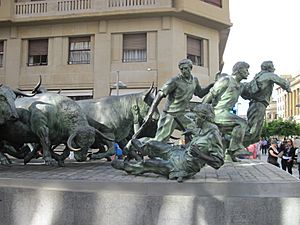
CA Osasuna is Pamplona's local football team. Their home stadium is called El Sadar.
Pamplona's bull ring was rebuilt in 1923. It can hold 19,529 people, making it the third largest in the world.
Other popular sports in Pamplona include team handball (with the former European champion team Portland San Antonio), futsal, and water polo.
Pamplona is also known as the hometown of Miguel Indurain, a famous cyclist who won the Tour de France five times. Former Arsenal goalkeeper Manuel Almunia is also from Pamplona.
The Movistar Team, a professional cycling team, is based near Pamplona.
Pamplona is home to the headquarters of the International Federation of Basque Pelota (FIPV). Basque pelota is a traditional sport played in Spain, France, and other countries.
Notable Citizens
- Fermin (* 272; † 303)
- Pablo de Sarasate (1844–1908), a famous composer and violin player
- Sabicas (1912–1990), a well-known flamenco guitarist
- Alfredo Landa (1933–2013), a popular actor
- Serafín Zubiri (born 1964), a singer
- Jon Andoni Goikoetxea (born 1965), a Spanish footballer
- Manuel Almunia (born 1977), a Spanish footballer
- Fernando Llorente (born 1985), a Spanish footballer
- Raúl García (born 1986), a Spanish footballer
- Nacho Monreal (born 1986), a Spanish footballer
- César Azpilicueta (born 1989), a Spanish footballer
- Iker Muniain (born 1992), a Spanish footballer
- Mikel Merino (born 1996), a Spanish footballer
- Amaia Romero (born 1999), a singer
- Nico Williams (Born 2002), a Spanish footballer
- Oihan Sancet (Born 2000), a Spanish footballer
Twin Cities
Pamplona is connected to these cities around the world:
See also
 In Spanish: Pamplona para niños
In Spanish: Pamplona para niños



